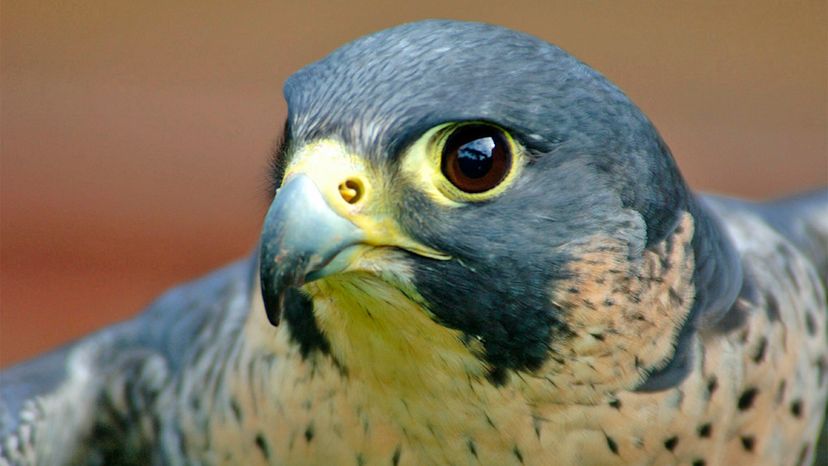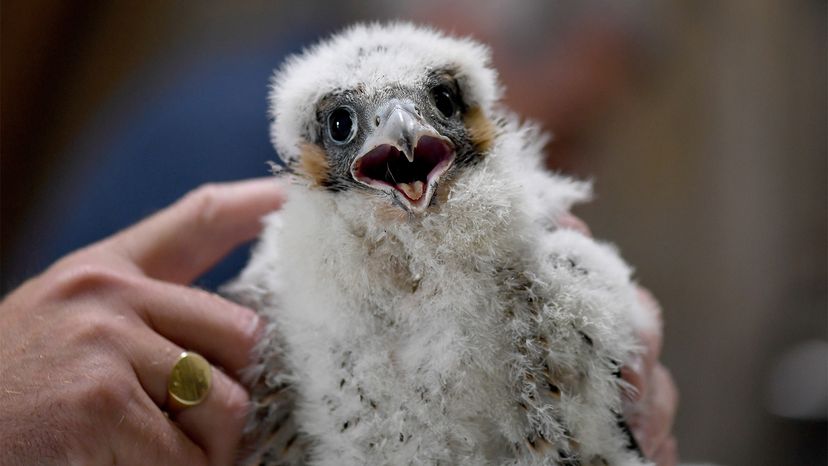The Fast and Furious Peregrine Falcon Is a Midair Hunting Machine
by https://www.howstuffworks.com/about-wendy-bowman.htm
In 2005, a fellow named Ken Franklin of Friday Harbor, Washington, used a computer chip to clock the diving speed of one of the peregrine falcons he owned — "Frightful," a 6-year-old bird weighing in at a little over 2 pounds (0.9 kilogram). The result? The bird dove after prey from about 3 miles (5 kilometers) in the air at a speed of 242 mph (389 kph), and with the speedy swoop broke a Guinness World Record for the fastest dive by a bird, making the peregrine falcon one of the world's fastest animals.
Referred to as global birds, the peregrine falcon (Falco peregrinus) can be spotted on every continent except Antarctica, traveling long distances (peregrinus means traveler in Latin) between their wintering and breeding grounds. North American peregrine falcons can be migratory or non-migratory, with some residing year-round in Alaska, the Midwest, Northeast, Southwest and along the Western Coast, while others migrate annually from South America and the Gulf Coast to the Alaskan tundra.
"They prefer wide-open spaces, and do well near coasts where shorebirds are common, but can be found from the tundra to deserts to forests," says Rick Schwartz, San Diego Zoo Global Ambassador, in an email interview. "They are strong, efficient flyers and skilled at catching a variety of prey. This versatility allows them to live in almost any type of climate and habitat. Basically, they can live wherever they can find food."
Among the identifying characteristics of these raptors (or birds of prey): "Peregrine falcons are the largest falcon over most of the North American continent, with long, pointed wings and a long tail," says Schwartz. "Adults are blue-gray above, with their underside having alternate bands of colors and a dark head with thick sideburns. They have sharp, yellow talons to catch their prey, and as with most raptors, males are smaller than females. The average peregrine falcon weighs from 1 to 3.5 pounds (0.4 to 1.6 kilograms), has a wingspan of 31 to 48 inches (79 to 122 centimeters) and an average body length of 13 to 20 inches (33 to 51 centimeters).

Peregrine Falcon Facts
Here are five other facts you might not know about this fascinating bird of prey, which is also unofficially known as the great-footed hawk, ledge hawk, stone hawk, rock hawk, bullet hawk and wandering falcon.
1. They Use Their Strong, Sharp Yellow Talons — and Incredible Eyesight — to Capture Other Birds, Even While in Flight
Peregrine falcons eat mostly other birds, with about 450 North American species having been documented as prey by the National Wildlife Federation. Among them: birds as large as sandhill cranes and as small as hummingbirds, as well as shorebirds, ducks, grebes, gulls, pigeons and songbirds. They also eat bats, and they often swipe fish and rodents from other raptors.
"A hunting peregrine typically catches its prey in the air with fast pursuits, rapid dives, and other impressive aerial maneuvers for which these falcons are known and admired," says Schwartz. "Peregrine falcons will sometimes dismember their prey and eat it in flight, or they will land with their prey in a safe spot, pluck the feathers and eat. They also have a sharp tooth at the end of their beak they can use to sever their prey's neck.
"Because peregrines are a bird of prey, they are near the top of the food chain and have very few predators," he adds. "However, adults may be killed by other large birds of prey, such as great horned owls."
2. Their Teardrop-Shaped Body Is Truly One of the Most Aerodynamic Designs in Nature
In fact, it's been studied and copied by airplane manufacturers for decades, says Nicole Ellis, a pet expert and certified trainer with Rover.com, via email. "Their rocketing down from the sky is like a blur," she says. "The force from the air, traveling at such a speed, would explode the bird's lungs, but baffles in the nose prevent this ... just another feature that has been studied and used in jet engines. Sophisticated membranes in the bird's eyes prevent them from drying out, so the predator can remain fixed on the target."
3. They Devote Themselves to One Partner
"They mate for life and return to the same nesting spot each year," says Schwartz. "When looking for a mate, male peregrine falcons have to work hard to impress the females. To keep her attention, males bring females food during the courting and nesting season. She frequently takes the prey from him while they are both in flight by turning upside down in mid-air and grabbing the food out of his talons!"
4. They're Featured on Idaho's 2014 Commemorative Quarter
Idaho was the 43rd state, and its quarter is No. 43 in the U.S. Mint's "50 State Quarters Program." The Gem State selected the peregrine falcon (which can be found throughout Idaho) and an outline of the state as images for its design. Although the state bird is the mountain bluebird, the state chose the peregrine falcon as the state raptor in 2004.
5. It's Illegal to Own a Bird of Prey in the U.S.
"The only exceptions are licensed falconers," says Schwartz. "Falconry is legal in all states, except Hawaii and the District of Columbia. Acquiring a falconry license in the U.S. requires passing a state written test, having equipment and facilities inspected, and serving a minimum of two years as an apprentice under a licensed falconer, during which time, the apprentice falconer may only possess one raptor."
Now That's Interesting
The peregrine falcon is considered one of the world's most common birds of prey. "In the mid-1900s, pesticides had a devastating effect on many bird species in North America, including peregrine falcons and their numbers dwindled," says Schwartz. "Today — thanks to the work of The Peregrine Fund and many other organizations — the peregrine is listed as a species of least concern on the IUCN [International Union for Conservation of Nature] Red List of Threatened Species."